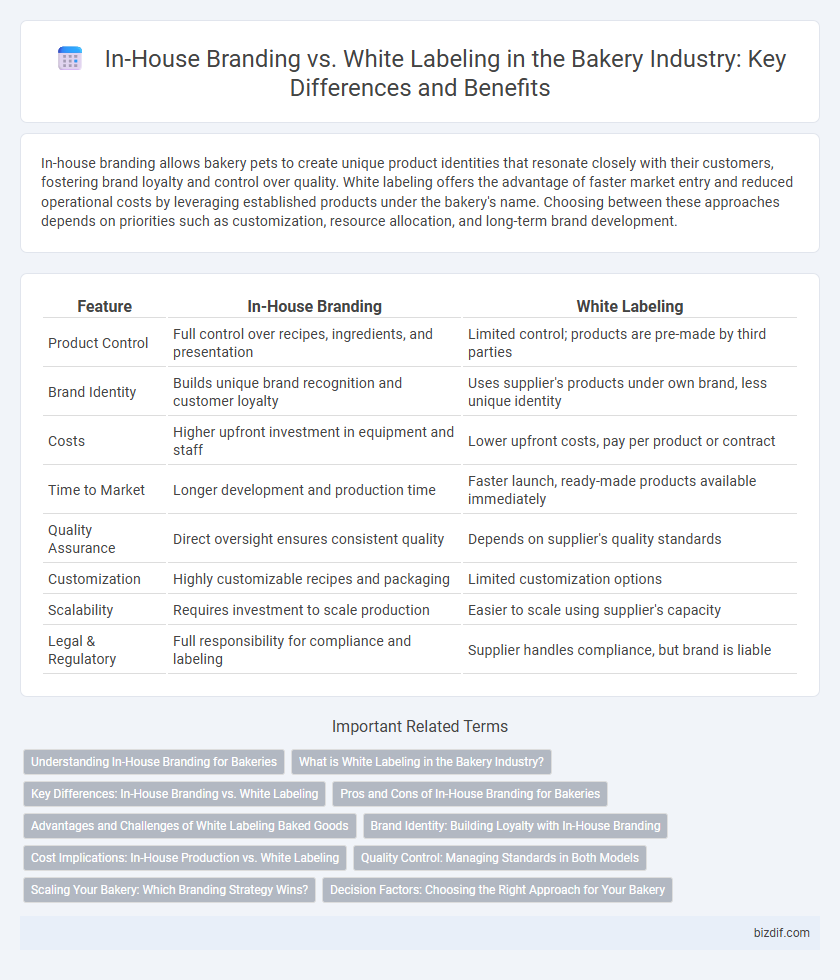In-house branding allows bakery pets to create unique product identities that resonate closely with their customers, fostering brand loyalty and control over quality. White labeling offers the advantage of faster market entry and reduced operational costs by leveraging established products under the bakery's name. Choosing between these approaches depends on priorities such as customization, resource allocation, and long-term brand development.
Table of Comparison
| Feature | In-House Branding | White Labeling |
|---|---|---|
| Product Control | Full control over recipes, ingredients, and presentation | Limited control; products are pre-made by third parties |
| Brand Identity | Builds unique brand recognition and customer loyalty | Uses supplier's products under own brand, less unique identity |
| Costs | Higher upfront investment in equipment and staff | Lower upfront costs, pay per product or contract |
| Time to Market | Longer development and production time | Faster launch, ready-made products available immediately |
| Quality Assurance | Direct oversight ensures consistent quality | Depends on supplier's quality standards |
| Customization | Highly customizable recipes and packaging | Limited customization options |
| Scalability | Requires investment to scale production | Easier to scale using supplier's capacity |
| Legal & Regulatory | Full responsibility for compliance and labeling | Supplier handles compliance, but brand is liable |
Understanding In-House Branding for Bakeries
In-house branding for bakeries involves creating and promoting unique products under a bakery's own name, which enhances customer loyalty and establishes a distinct market presence. This approach allows full control over product quality, brand identity, and customer experience, leading to stronger recognition and trust. Investing in in-house branding can result in higher profit margins compared to white labeling, as exclusive recipes and packaging attract repeat customers and brand ambassadors.
What is White Labeling in the Bakery Industry?
White labeling in the bakery industry involves producing baked goods that are packaged and sold under another company's brand name, allowing businesses to offer a variety of products without developing recipes or production processes. This strategy enables retailers and cafes to expand their product range quickly while leveraging the expertise and facilities of established bakeries. White labeled bakery items often include bread, pastries, and specialty cakes, providing a cost-effective way to meet consumer demand with consistent quality.
Key Differences: In-House Branding vs. White Labeling
In-house branding in a bakery involves creating unique recipes, packaging, and marketing under the bakery's own name, fostering direct customer loyalty and brand recognition. White labeling allows bakeries to sell baked goods produced by another company under their own brand, minimizing production costs and operational complexity. Key differences include control over product quality, customization capabilities, and the extent of brand identity development.
Pros and Cons of In-House Branding for Bakeries
In-house branding for bakeries allows complete control over product quality, packaging, and customer experience, enabling a strong, unique identity that can foster customer loyalty and differentiate from competitors. However, it requires significant investment in marketing, product development, and consistent innovation, which can strain resources for small or new bakeries. Unlike white labeling, in-house branding demands ongoing commitment to brand management and higher upfront costs but offers greater long-term value through stronger brand equity.
Advantages and Challenges of White Labeling Baked Goods
White labeling baked goods allows bakeries to expand product offerings quickly without investing in new recipes or production facilities, leveraging established brands to boost sales and market reach. Challenges include maintaining consistent product quality, potential loss of brand identity, and reliance on third-party manufacturers for supply chain reliability. Careful vendor selection and quality control are essential to maximize the advantages of white labeling in competitive bakery markets.
Brand Identity: Building Loyalty with In-House Branding
In-house branding in a bakery strengthens brand identity by creating a unique and recognizable product line that resonates with customers, fostering long-term loyalty. Unlike white labeling, in-house branding allows bakeries to control every aspect of the product, from recipe to packaging, ensuring consistency and authenticity. Strong brand identity through in-house branding drives repeat business and differentiates the bakery in a competitive market.
Cost Implications: In-House Production vs. White Labeling
In-house branding in bakeries involves higher initial costs due to equipment investment, ingredient sourcing, and skilled labor, but offers greater control over product quality and brand identity. White labeling reduces upfront expenses by outsourcing production to established manufacturers, allowing bakeries to enter the market quickly with minimal operational costs. Long-term profitability depends on balancing cost savings from white labeling against potential revenue from unique, proprietary products developed through in-house production.
Quality Control: Managing Standards in Both Models
In-house branding in bakeries allows for complete quality control, ensuring consistent ingredient sourcing, baking processes, and product presentation that reflect the bakery's standards. White labeling involves outsourcing production, which requires rigorous supplier vetting and regular audits to maintain quality across third-party products. Both models demand strict quality management systems to sustain customer trust and brand reputation in a competitive market.
Scaling Your Bakery: Which Branding Strategy Wins?
Scaling your bakery effectively hinges on choosing between in-house branding and white labeling, each offering distinct advantages. In-house branding fosters unique brand identity and customer loyalty by showcasing original recipes and personalized packaging, critical for long-term growth. Conversely, white labeling accelerates market entry and expands product variety by leveraging established brands, ideal for rapid scaling with lower upfront costs.
Decision Factors: Choosing the Right Approach for Your Bakery
Choosing between in-house branding and white labeling in a bakery hinges on factors such as control over product quality, brand identity strength, and investment capacity. In-house branding demands a higher initial investment and provides full creative control, ensuring the bakery's unique recipes and story resonate with customers. White labeling offers cost efficiency and quicker market entry by leveraging existing products, but may limit customization and brand differentiation.
In-house branding vs White labeling Infographic

 bizdif.com
bizdif.com